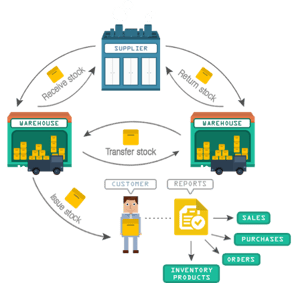Understanding Inventory Control
Inventory control, sometimes referred to as stock control, is a broad topic and incorporates many different functions making it difficult to describe in a limited definition, but here is my definition drawn from my 30 plus

years of experience in supply chain operations: Inventory control is all aspects of managing a company’s inventories: from purchasing through shipping, receiving, tracking
Inventory control allows you to have the right amount of stock in the right place at the right time. It ensures capital is not tied up unnecessarily, and protects production if problems arise within the supply chain. It applies to every item you use to produce a product or deliver a service, from raw materials to finished goods. It covers stock at every stage of the production process, from the initial purchase and delivery to the consumption or use of it and eventually to re-ordering., warehousing and storage, adjustments and more.
Inventory control is such a critical piece of an organization’s operations and bottom line that it is too important to leave to human error or antiquated, out of date systems. This is why many companies opt to invest in inventory control systems, so all components are managed by one central integrated system.
Effective Inventory Management
There are two key concepts that underpin effective inventory management:
1) Clearly defined decision-making responsibilities and processes at strategic, tactical, and operational levels.
2) Coordination across enterprise supply chain functions, particularly between planning and logistics.
Although time horizons can vary by industry, the strategic level generally has a horizon of more than one year and may be associated with significant capital investment. The operational level has a short to medium horizon of 1 to 18 months, while the tactical level has an immediate horizon of typically several weeks.
Companies need to approach the supply chain and inventory management first at the strategic level, where fundamental decisions are made with respect to the company’s business objectives. Often, this may include the use of demand planning applications that look backward and forward to help determine a long-term plan. Once decisions are made at the strategic level, business decisions at the operational level and finally, the tactical level can be addressed, with each level following the objectives and decisions of the next level.
In respect to those levels, here are some considerations:
- Understand the strategic performance attributes for your company and how they influence your objectives, decisions, processes and metrics at each level.
- At the strategic level, seek to understand and balance the trade-offs between inventory and logistics relative to your supply chain network and inventory deployment strategy.
- At an operational level, be part of the process to assess the feasibility of short- to- medium-term plans that affect inventory and logistics. Set and communicate clear goals for your inventory control that include measurable objectives. (I.E. according to the Warehouse Education and Research Council, WERC, to be among the top 20% of companies, best of class in terms of inventory accuracy, your inventory accuracy target is 99.888%.)
- At the tactical level, leverage technologies, including WMS, to insure all activity is being tracked and directed. As the old adage goes, you can’t fix what you can’t measure.
- Leverage the visibility tools in these products to increase flexibility and drive towards perfect execution in a cost-effective manner. Advances in information technologies and the increasing availability of data in real time, allow companies to continuously innovate their operating models to create differentiation in the marketplace.
Inventory control is in many respects the heart of supply chain management. Companies that recognize this and meet the challenge through planning, systems and execution will reap the rewards and position themselves for the best chances of long-term success.

